cam gordon
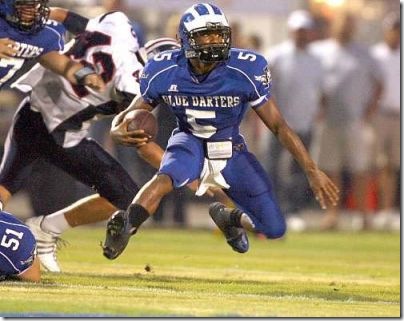
Gallon's levitation skills translated to the college game just fine.
Previously: 2008 Offense, 2008 Defense, 2009 Defense, 2009 Quarterbacks
Finishing out the series looking back on the 2009 recruiting class, here's a look at the non-quarterback offensive players, as described in Brian's recruiting posts of yore. But first...
My Bad, Cam
While I remembered to include then-OL, future-NT Quinton Washington on the defensive side of the ball, I forgot to do the same for Cam Gordon, the future defensive positional nomad who came to Michigan with most recruiting services considering him a wide receiver. As Gordon's recruitment wore on, it became more clear that his best spot may actually be in the defensive back seven, and thus we got one of the odder player comps I've seen:
Jason Avant, or maybe Prescott Burgess
Why Avant or Burgess? Bulky 6'2" wide receiver who will push 215 and lacks deep speed == Avant. Rangy linebacker who needs to put on 20 pounds, switch positions (sort of) and probably struggle with the mental part of being a college linebacker for a while == Burgess.
Free safety wasn't mentioned, because only an insane, desperate person would put a player matching that profile on the last line of defen--AAAAAAIIIIIIIIIIGGGGHHHHHH. (Thank you, Denard, forever and always.)
Gordon ended his career as a backup outside linebacker and situational defensive end. Fire Tony Gibson again, just in case.
The Blue Darter
As for prospects who actually ended up at receiver, Michigan had two: consensus top-200 prospect Je'Ron Stokes, and a high school single-wing quarterback who—despite being an Army All-American—earned four-star status on just one site due to his diminutive stature.
PEAK MIXTAPE WEEZY WITH A KEVIN FEDERLINE REFERENCE.
HOW DID IT GET SO LATE SO SOON?
Though everyone pegged Jeremy Gallon as a pure slot ninja—he'd prove to be much more, obviously—the eye-opening highlights and strong Army week performance earned him plenty of hype:
Gallon is a Swiss Army knife of a player: pocket-sized, versatile, capable of surprising feats, and… uh… hard to tackle. (If you've ever tried to tackle a Swiss Army knife you know what I'm talking about. They're pointy.) It's hard to envision a scenario in which one of his diverse and sundry talents doesn't find him on the field, if not this fall than next.
Brian, I'd like to hear more about your past attempts to ... tackle ... pocket knives.
As for Stokes...
When Je'Ron Stokes committed to Michigan I was in an airport about to board a plane for Egypt by way of Germany, and as soon as he did I logged off and forgot all about him. Ever since when something reminds me of that commitment, it's like a weird bonus: oh, yeah, that universally-praised wide receiver in the class I never remember. He's like a ghost recruit.
Yeah, that was for the best.
Oh Damn, Fitz
From 2008-09, I worked as an intern at The Wolverine, and one of my primary tasks during football season was posting the stats of Michigan's commits each week. A back from Ohio's Division V Youngstown Liberty by the name of Fitzgerald Toussaint committed a few months before I got that job, so week after week that fall I'd look up his stats, bug out my eyes, and get incrementally more excited for him to see the field at U-M:
Fitzgerald Toussaint, Youngstown Liberty: Senior RB and Michigan recruit went over 250 yards for the seventh week in a row in a 33-28 win over Hubbard. After generating 16 yards on four carries in the first half, Toussaint erupted for 235 yards in the second half and scored two TDs. He has 1,950 yards in eight games.
He'd finish the season with over 2,200 yards and 28 touchdowns. Between those numbers and his excellently soundtracked highlights, I thought he'd be the next great Michigan running back:
That wasn't to be, at least in large part for reasons outside his control, but when remembering where Toussaint came from...
It wasn't all flowers and 90-yard touchdowns for Toussaint, though. His dad—also named Fitzgerald Toussaint—ended up in jail after stabbing his ex-wife's boyfriend… at a football scrimmage. Nasty business.
...I'd say 32 career starts, graduating from U-M, and getting a shot to make an NFL roster constitutes a very successful college career.
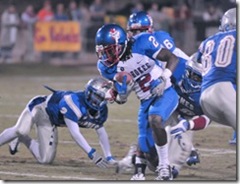 Vincent Smith's profile started out with similar recounting of a tough upbringing in Pahokee, then mostly waffled between excitement about his highlights/fit in the scheme and trepidation about his size, which was the subject of an awkwardly written ESPN scouting report:
Vincent Smith's profile started out with similar recounting of a tough upbringing in Pahokee, then mostly waffled between excitement about his highlights/fit in the scheme and trepidation about his size, which was the subject of an awkwardly written ESPN scouting report:
ESPN says Smith lacks size "on paper"—which uh what about real life too—and says he runs "low to the ground," as if he has a choice.
Sadly, no mention of fingerguns or being a heat-seeking, defender-destroying missile.
Michigan rounded out a three-man running back class with Cass Tech product Teric Jones, who recorded the fastest time at the Army combine after his junior year but didn't receive much at all in the way of recruiting hype. By the time he got to campus the coaches were already considering a position switch:
In fact, Michigan might be shooting Jones into lots of space as a slot receiver. Rodriguez said Jones was a slot receiver who "may also get reps at running back" at the signing day press conference, and Jones did have some nice receiving numbers as a junior: 24 catches for 306 yards.
Jones ended up playing special teams as a true freshman, bounced between running back and cornerback as the thin roster dictated need, then left the team and went on medical scholarship before the 2011 season after a sophomore-year knee injury.
If You Just Take Two Linemen...
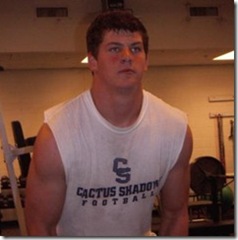
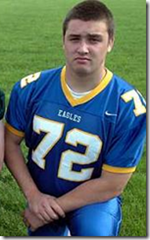
...you might as well make them NFL linemen, and that's exactly what happened with U-M's 2009 O-line class of Taylor Lewan and Michael Schofield. Lewan, especially, was quite the steal; he was a total unknown until moving from defensive line to offensive line before his senior season, then vaulted into the top 300 recruits on all three recruiting services and played in the Under Armour AA Game in his first year playing the position. Michigan had a nice in with Lewan—his teammate at Chaparral High, Craig Roh, had been committed to U-M for months when Lewan decided to also head to Ann Arbor.
While this usually doesn't happen, Lewan's high school coach ended up giving the most accurate forecast of his player's potential:
“Michigan is getting, in my opinion, the steal of this year's recruiting class in the country,” Ragle said. “I know that's a bold statement to make, (but) this kid’s ability on the field won't be questioned. He's as good an athlete on the offensive line as I've ever seen.”
...
"He's as good athletically as any guy I have ever coached," Ragle said. "The thing that makes him so special is his upside when you think he's only been coached at the position for about eight months. But the one intangible that's most impressive is his nastiness --Taylor wants to burry [sic] someone on every play, and you can't coach that."
On point, Coach Ragle.
Schofield's rankings were in a similar range as Lewan's after a strong senior season. What stood out about him most was his athleticism—which translated to the college game, as he seamlessly transition from being Michigan's best pulling guard to a nimble pass-protector at tackle—and considering he's now 6'7" and 300+ pounds this is rather astounding:
In his first two years at Sandburg, Schofield ran the 110 high hurdles for the Eagles’ track team, winning a conference title his freshman year and finishing second his sophomore season. He also moved up to the varsity team for the state tournament during his sophomore year, finishing sixth in sectionals.
Unfortunately, there's no video of this, as the age of someone-on-a-smartphone-will-film-literally-anything hadn't hit yet.
So, with that exercise out of the way, who's ready to go over the 2010 class?
On second thought, let's save that for next summer. Or perhaps never. Leaning towards never.
![jerry-maguire[1] jerry-maguire[1]](https://mgoblog.com/sites/mgoblog.com/files/images/Mailbag_117F2/jerry-maguire1.jpg)
![md19[1] md19[1]](https://mgoblog.com/sites/mgoblog.com/files/images/Mailbag_117F2/md191.jpg)
SHOW ME THE HENRY
How to resolve the NCAA being terrible thing.
Brian,
My friend and I were having a discussion about the best way to compensate college players, and he came up with the idea of paying players based on performance, sort of how incentive laden contracts work in the NFL, with the stipulation that the players will not receive the money until they graduate or go pro. I thought his idea was awful and unrealistic, because the “student athletes” would now become paid employees of the university and we essentially would have a semi-pro league on our hands. BUT, that got me thinking about a possible solution…
The issue we have here is the balance of compensation between stars and bench-warmers, large schools and small schools, men’s sports and women’s sports (which could also very well be a legal issue), revenue-generating and non-revenue-generating sports, etc. Instead of trying to figure out that mess, let’s take the decision of compensation out of the universities’ hands.
The solution: allow the student athletes to sign endorsement deals. If a corporation is willing to pay for a player’s likeness, he deserves that money. However, the stipulation here is that all money earned by a student athlete through endorsements would have to be held in an escrow account, and the release of the money would be contingent upon the completion of the player’s eligibility or his/her declaration to go pro, whichever comes first. Now if a player is caught accepting benefits beforehand, the NCAA would not look hypocritical when laying down punishments. Student athletes get compensated, legal issues are avoided, and you won't have a bunch of teenagers running around campus with millions of dollars to blow/get into mischief with. What do you think? So crazy it just might work?
Go Blue,
Stephen Y
That's fine. It's a little paternalistic to tell the kids they can't have money until they get their degree, and that will be less effective at legitimizing the stuff under the table, because poor college kids will still want walking-around money. It's still fine.
I'm not sure why there's this widespread opposition to giving people money in exchange for services, but whatever middle ground you want to stake out that gives the kids their image rights and avoids Title IX issues is fine by me. Sign whatever you want, get whatever money you can acquire, and everything will be the same except compliance folk will have to find less mindlessly pedantic jobs. Worries about booster involvement are naïve—they're already involved.
The other major thing that the NCAA could do is get rid of their inane opposition to agents. If you're a legit agent with X number of current pro clients you can sign players regarded as prospects, and give them some advance on whatever they're going to make in the pros. (If you don't make the pros, that's just tough luck for the agent.) The NCAA doesn't even have to redirect any of the buckets of cash they're currently making to make the system
- less impossible to manage
- a more even playing field
- fairer to the players
-
Yeah: a more even playing field. Right now no one is going to MAC schools over major offers, but schools willing to do under the table stuff—or just not stop it—have an advantage over schools that don't. And it's tough to figure out what the more moral position is there these days.
-
DL moves?
Hey Brian,
Sometimes in football, it seems that you just want to get the best guys on the field right? Do you think we might see a DL consisting of Beyer, Henry, Qwash, Black?
I would think Black could flip back out to SDE pretty easily and could fold back in to 3 tech occasionally depending on the substitution patterns. To me that gets your best pass rushers on the field more regularly and is the most likely combo to soak up OL in the run game too.
You mentioned that you expect Beyer to take Clark's job when Ryan comes back, but why not just make that switch now? Wouldn't you rather get Gordon out there with Beyer than Clark at this point?
Thanks,
Daniel
(This was sent before Clark played well against UConn.)
If Michigan was going to put out its best line for one particular play against an I-formation that might well be it, but with opponents running out all kinds of spread packages and Michigan responding by lifting their nose tackle, Black's snaps are mostly going to be spent as an interior rush-type against shotgun formations. It's probably not worth moving him midseason to get a marginal improvement. While I like what I've seen from Henry so far, there was a play against UConn where he got obliterated. (Michigan was fortunate that UConn didn't block the second level well and held the gain down.) He's a work in progress.
Meanwhile on Cam Gordon: for whatever reason they're not playing him, and it's to the point that his lack of playing time speaks to a lack of performance. Beyer's been good, but mostly as a guy with his hand in the dirt. When Beyer's been put in coverage he's shown some flaws. Gordon's not getting more time is probably just his fate at this point.
I don't get it, either. They've been giving him seemingly genuine praise for years now and when it comes down to it they just don't put him on the field.
[After THE JUMP: evaluating Michigan's coaching staff, plus Bo Pelini axe murder.]
FORMATION NOTES: Michigan played this one vanilla, opting for either their traditional 4-3 under…
![2013starters_thumb_0[1] 2013starters_thumb_0[1]](https://mgoblog.com/sites/mgoblog.com/files/images/Upon-Further-Review-2013_1429F/2013starters_thumb_01.jpg)
…or a 4-2-5 nickel package…
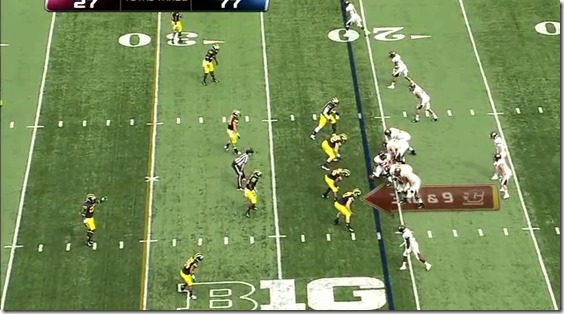
Furman is offscreen on the right hash.
…with the occasional insertion of a 3-3-5 on passing downs. There was no okie stuff with seven guys at the line of scrimmage, and it was very rare to see a safety walk down. With the line ripping through Central's pass protection there was little need to do anything else. If Michigan could manage that against a tough opponent that would be nice.
SUBSTITUTION NOTES: ALL OF THE SUBSTITUTIONS
Right. Seth has already covered this in exacting detail. In brief: the secondary was consistent, with Furman and Wilson at safety and Taylor and Countess the starting corners. When Michigan went to the nickel, Stribling and Hollowell were about even, with Stribling getting the first at-bats.
Inside linebacker was split almost evenly between Morgan, Ross, and Bolden, with Gedeon getting some reps later and RJS right at the end. SAM was about 50/50 Beyer/Gordon, except that a lot of that was at DE in nickel packages.
Okay. The line. Okay. Your nominal starters were Heitzman, Washington, Black, and Clark, except there was so much nickel that the nose was lifted half the time. Wormley, Pipkins, Glasgow, and Ojemudia got a large amount of time backing up the starters. Godin, Ash, Henry, and Charlton got in later. Godin actually split snaps almost equally with the other two SDEs; at the other three spots the third guy was definitively third.
[After THE JUMP: rotation, rotation, rotation. Pass rush! Safety assessments!]
27